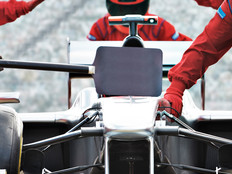University of Pittsburgh Uses Technology to Drive Sports Success
When the University of Pittsburgh moved from the Big East Conference to the Atlantic Coast Conference in mid-2013, Athletic Director Steve Pederson wanted to give his student athletes a competitive advantage against the new teams they would face. He invested in technology.
Pitt’s football and basketball teams initially took advantage of the latest video equipment to record practices and games. The athletic department has since introduced high-definition (HD) video technology to 16 other Division I teams, including track and field, soccer, tennis and gymnastics.
“Our focus with this project was to provide our Olympics sports with every competitive tool available as we transitioned to the ACC. One way we felt we could easily do that was to create an Olympic sports video department and make a financial investment in technology,” says Jeff Irwin, the University of Pittsburgh’s assistant athletic director for technology.
College athletics departments nationwide, including Pittsburgh’s, are making great strides with digital video as HD cameras become more affordable and mobile devices and tablets become nearly ubiquitous.
Cloud-based services or internal network-based systems that stream video also make it easier and more affordable for coaches and athletes to review footage from practices and games. Video allows teams to analyze performance and correct mistakes. Some coaches are incorporating wearable video cameras and drones to watch the action from new and unique perspectives.
Rick Neuheisel, a Pac-12 Sports Network football analyst and former UCLA football head coach, says such technology helps teams develop game plans and gain a competitive edge, but also serves as a good teaching tool.
“Coaches, historically, are creatures of habit and don’t necessarily accept technology as quickly as others. But because students are so adept at new technology, the smarter, wiser coaches have realized that they have to adapt,” he says.“The more you can use what the kids are using, the more you can get them to digest the information you want them to digest.”
Technology Gives Team a Competitive Boost
When Brian Templien left the NFL’s Tampa Bay Buccaneers and joined the University of Pittsburgh as video director of Olympic sports, he spent much of his first year in startup mode.
The approximate amount of time it takes the University
of Pittsburgh’s video department to make game footage available to coaches once a game is complete
SOURCE: Brian Templien, University of Pittsburgh
He purchased wearable and pan-tilt-zoom (PTZ) HD video cameras, equipped coaches with tablets and notebook computers and deployed a cloud-based service that allows the athletics department to upload, store, edit and playback video footage on any computing device.
Pitt’s wrestling, gymnastics, swimming and volleyball teams previously used standard-definition video technology, so the HD equipment represented a major upgrade. Meanwhile, some teams gained the opportunity to leverage video for the first time, including track and field, tennis, soccer, baseball and softball.
“A lot of our teams didn’t know the benefits of filming,” Templien says. “The first couple of weeks were tough, but they started to use it and see the benefits. Now, they’re coming up with ideas and asking, ‘How about doing this?’ It’s cool to see.”
So far Templien has invested in 12 GoPro video cameras — small, portable HD camcorders that are wearable, waterproof and drop-proof — perfect for traveling and filming road games, recording swimmers underwater and obtaining unique shots from the athlete’s point of view, he says.
In track and field, the video department can set up three cameras to film practices, positioning two on tripods in front of and behind athletes and a third on top of an athlete’s head to better see what the athlete sees. Coaches can analyze the footage after practice and use it to help athletes fix any flaws.
“A lot of sports are technique-driven. It’s important for both our student athletes and coaches to be able to review the smallest detail while they are training for a competition,” Irwin says. “The goal is to use video to improve your technique, and by improving your technique you can improve your results.”
Pitt Athletics installed multiple Panasonic PTZ video cameras at its baseball, soccer and softball fields to provide video from different angles.
During games, video department staffers record each play and categorize the action. Later, coaches and players log in to the university’s cloud provider, search for a specific type of play, and all matching results are displayed. A soccer coach can review all shots on goal, while a baseball coach can review at-bats to get a better view of players’ hitting mechanics.
“If batters are slumping, you can pull up video of their batting stances when they were doing well and compare that to current footage to see what they’re doing differently,” Templien says.
Getting a Birds-Eye View of the Field with Drones
The athletic department at Fresno State University purchased a drone last summer to provide its football team with a bird’s-eye view of its practices. The video staff attached a GoPro camcorder to the drone and uses a remote-control to fly it during practices, about 25 feet above the players and about 15 feet behind the quarterback.
“It provides our coaches with a perspective they’ve never seen before,” says Brad Blackstone, Fresno State’s manager of video operations. His department also uses the drone to back up security on game days at Bulldog Stadium with aerial views of fan entry gates. “We can see if we are bottlenecked somewhere, and it helps give them an idea of the security situation,” he says.
Fresno State implemented HD video two years ago, and the improved quality immediately helped coaches, starting with the ability to see players’ numbers.
“In soccer and basketball, players are continuously moving back and forth. Coaches want to see who is the player getting back to play defense before anyone else,” Blackstone says. “With standard definition, you may not make out the number. With HD, you can zoom in and maintain clarity.”
The video department records football games with six Panasonic HD cameras and also issues tablets to its players. The department is considering whether to replace paper playbooks with digital playbooks when funding becomes available, Blackstone says. In the meantime, coaches are tapping cloud-based software to send video clips and messages to players.
The software allows coaches to mark up and draw on the videos as well as record commentary and provide detailed instructions to players.
“Coaches can show these players what the opponents are doing or anything else they need to work on,” he says.
Practice Tech Makes Perfect
The new basketball practice facility under construction at the University of Arkansas is already wired for video. Panasonic HD video cameras will overlook the women’s basketball court, providing views from the sidelines, baselines and possibly from the top of each basket, says Jeff Brazil, director of video and scouting coordinator for the women’s basketball team.
Near the bench, the team plans to include a flat-screen TV and computer with video-editing software, allowing Brazil and his graduate assistants to view, edit and analyze practices in real time. The setup also will allow coach Jimmy Dykes to show video replays to his players immediately during practices.
“When you tell players something, they may not hear it. But if you can show them something on film that they’re doing right or wrong, it becomes a great teaching tool,” Brazil says.
The new practice facility also will feature a video room with theater-style seating, allowing the Razorbacks’ coaches and players to view game film together on a large flat-screen television. Brazil’s assistants record games at home and on the road, with one managing the cameras and another cataloging the team’s offensive and defensive plays in real time, such as shots made, shots missed, blocks and steals.
After games, coaches and players can log in to the athletics department’s internal network–based system to review their performances on any computing device, including players’ smartphones.
Brazil also uses the technology to scout the team’s upcoming opponents. He analyzes video of competitors’ games, categorizes each play, shares the video with coaches and writes scouting reports that include details such as the types of defense a team may prefer or the direction players tend to drive the ball.
“Our belief is that if you play hard, are well prepared and know your opponent, you can win the game,” he says.
Teams Learn the Value of Data Analytics on the Field
Beyond watching and cataloging plays using video, some teams are taking their technology assist a step further by adding statistical analysis.
Fresno State relies on a software tool to crunch numbers pertaining to its football team’s opponents. Blackstone says graduate assistants build reports that include percentage breakdowns of an opponent’s play selection in certain situations, such as third-down opportunities, “preparing our team on what to expect in certain situations.”
In Pittsburgh, where the video department was launched successfully and user and staff training are now complete, Templien is shifting his focus to analyzing opponents’ game footage and compiling analytics.
“If our baseball team is playing Florida State next, and we know the starting pitcher we will face, we can look at the data and know that he throws a fastball 68 percent of the time. He throws a curveball 27 percent of the time,” he says.
Overall, the technology already is helping the university’s teams improve how they prepare for competition.
“We have some great coaches and student athletes. It’s a combination of everything, from the technology to our students and coaches, top to bottom, that works together to succeed,” Irwin says.








